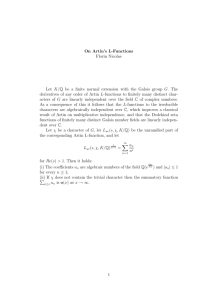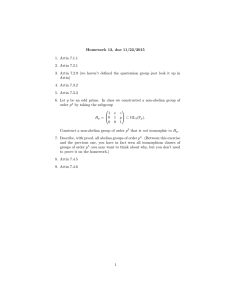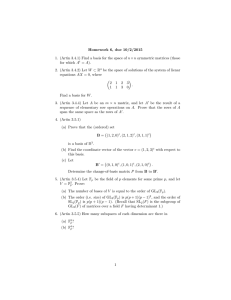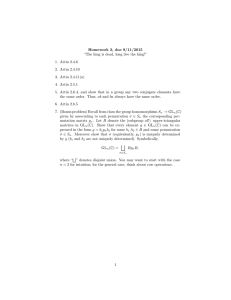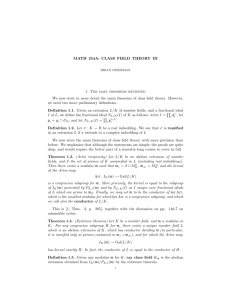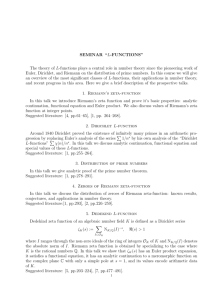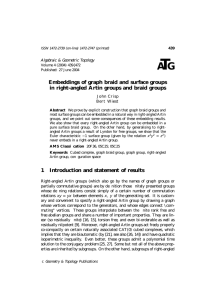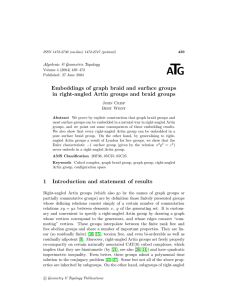Class Field Theory and Artin L
advertisement
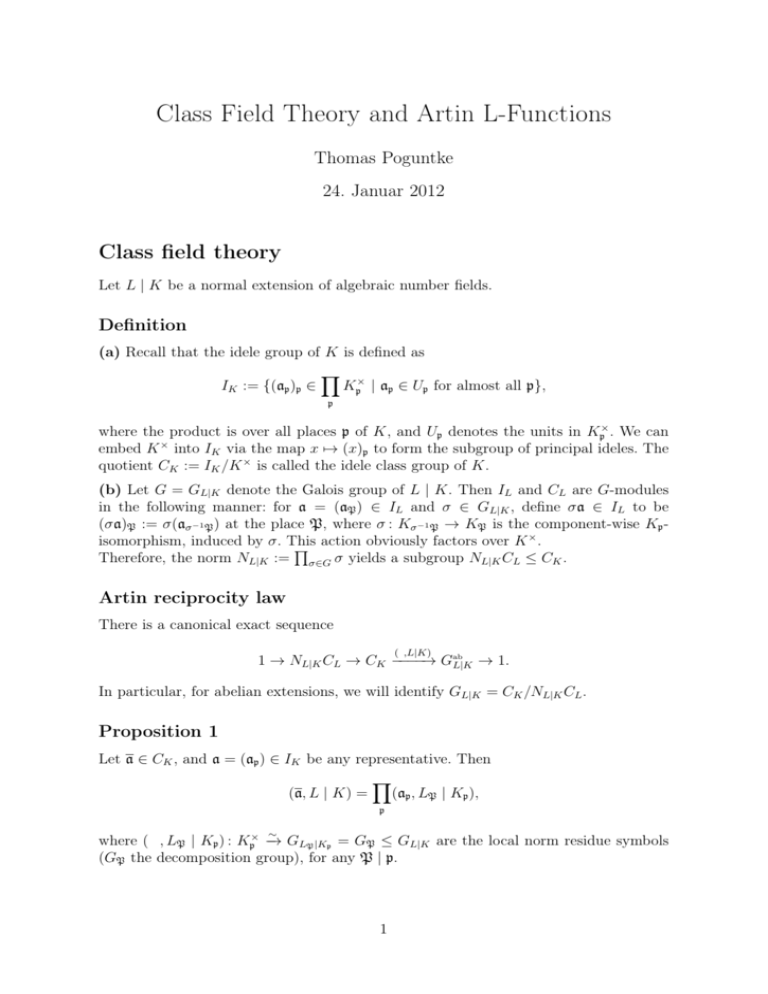
Class Field Theory and Artin L-Functions
Thomas Poguntke
24. Januar 2012
Class field theory
Let L | K be a normal extension of algebraic number fields.
Definition
(a) Recall that the idele group of K is defined as
Y
Kp× | ap ∈ Up for almost all p},
IK := {(ap )p ∈
p
where the product is over all places p of K, and Up denotes the units in Kp× . We can
embed K × into IK via the map x 7→ (x)p to form the subgroup of principal ideles. The
quotient CK := IK /K × is called the idele class group of K.
(b) Let G = GL|K denote the Galois group of L | K. Then IL and CL are G-modules
in the following manner: for a = (aP ) ∈ IL and σ ∈ GL|K , define σa ∈ IL to be
(σa)P := σ(aσ−1 P ) at the place P, where σ : Kσ−1 P → KP is the component-wise Kp ×
isomorphism, induced by σ. This
Q action obviously factors over K .
Therefore, the norm NL|K := σ∈G σ yields a subgroup NL|K CL ≤ CK .
Artin reciprocity law
There is a canonical exact sequence
( ,L|K)
1 → NL|K CL → CK −−−−→ Gab
L|K → 1.
In particular, for abelian extensions, we will identify GL|K = CK /NL|K CL .
Proposition 1
Let a ∈ CK , and a = (ap ) ∈ IK be any representative. Then
Y
(a, L | K) =
(ap , LP | Kp ),
p
∼
where ( , LP | Kp ) : Kp× −
→ GLP |Kp = GP ≤ GL|K are the local norm residue symbols
(GP the decomposition group), for any P | p.
1
Remark
Artin reciprocity is one of the main results of class field theory, and has many consequences. For example, it contains the quadratic reciprocity law as a (very) special case,
which is where the name comes from.
√
In fact, for a, b ∈ K × , let (a, b)p be the p-adic Hilbert symbol. Let L := K( b). Obviously, a = 1 ∈ CK , so proposition 1 states that
Y
Y
(a, LP | Kp ) =
(a, b)p ,
1 = (a, L | K) =
p
p
which is Hilbert’s reciprocity law. If then K = Q, and a = p 6= q = b are odd primes,
we have
Y
p−1 q−1
p
q
1=
(p, q)p = (−1) 2 2
,
q
p
p
the quadratic reciprocity law. For more details on this, see Bac:III.
Definition
A subgroup N ≤ CK is called a norm group, if there is a normal extension L | K, such
that N = NL|K CL .
Proposition 2
The map L 7→ NL := NL|K CL is an inclusion-reversing bijection between all abelian
extensions L | K and the norm groups of CK . The field L is called the class field of NL .
Existence theorem
The norm groups of CK are precisely the closed subgroups of finite index.
Example
Q
Q
1
1
1
1
K × /K × . Then, by definition, IK
≤ IK is
:= IK
:= p|∞ Kp× × p-∞ Up , and CK
Let IK
1
open, hence so is CK ≤ CK , and therefore closed. To compute the index, we observe
.
×
1
1
×
1
CK /CK
= IK /K IK
K × /K × = IK /IK K = Cl(K),
Q
the ideal class group of K. The last isomorphism is given by [a] 7→ [ p-∞ pνp (ap ) ].
1
This means we have [CK : CK
] = hK < ∞. Thus, by the existence theorem, we obtain
1
a normal (abelian) extension L | K, such that CK
= NL|K CL , and so
1
= Cl(K).
GL|K = CK /NL|K CL = CK /CK
We call L the Hilbert class field of K. There are some nice results for L:
Proposition 3
The Hilbert class field of K is the maximal unramified abelian extension of K.
2
Principal ideal theorem
In the Hilbert class field L of K, any ideal of K becomes a principal ideal, i.e. the
natural map Cl(K) → Cl(L) is trivial.
The last result from class field theory we want to mention, is the following:
Proposition 4
Let L | K be abelian, n := [L : K], p an unramified prime ideal of K. Furthermore, let
π ∈ Kp× be a prime element, π̃ ∈ CK the class of the idele (. . . , 1, π, 1, . . .) ∈ IK , as well
as f the order of π̃ in CK /NL|K CL . Then p splits into r = nf distinct prime ideals of L:
p = P1 · · · Pr , each of inertia degree f .
Proof:
By Artin reciprocity, CK /NL|K CL = GL|K , so π̃ mod NL|K CL has the same order as the
element (π̃, L | K) = (π, LP | Kp ) ∈ GP (see prop. 1). From local class field theory, we
know that (π, LP | Kp ) = ϕP , the Frobenius morphism, hence f = ord GP = f (P | p),
the inertia degree. Then the fundamental equation n = rf yields our result.
Artin L-functions
Let L | K be a normal extension of algebraic number fields, and (V, ρ : G → GL(V )) a
representation of the Galois group G = GL|K .
Definition & lemma 1
Let p be a place of K, GP and IP the decomposition and inertia groups of P | p,
respectively. Then GP /IP ∼
= Gk(P)|k(p) is generated by the Frobenius morphism ϕP
(where k(p) denotes the residue field of p).
We can understand ϕP as an endomorphism of the fix module V IP V IP via ρ (caution!
we will call this ϕP = ρ(ϕP ) again!). Then the characteristic polynomial
det(1 − ϕP t; V IP )
is well-defined.
Proof:
If P, P0 | p, there is σ ∈ G such that P0 = σP, whence ϕP = σ −1 ϕP0 σ.
Definition
The Artin L-function of ρ is defined as
Y
L(L | K, χ, s) :=
p
1
,
det(1 − ϕP N (p)−s ; V IP )
where χ : σ 7→ tr(ρσ) is the character of ρ.
3
Remark
L(L | K, χ, s) is an analytic function on Re(s) > 1.
Example
Let K = Q, L = Q(µm ) (with µm the m-th roots of unity). If χ : GL|K → GL1 C is a
1-dimensional representation, we can use Artin’s reciprocity law θ : (Z/mZ)× ∼
= GL|K
×
×
to understand χ as a Dirichlet character (Z/mZ) → C . Note that θ(p mod m) = ϕp
for any prime p - m (this is also enough to establish the isomorphism; we will really
need Artin only later in our general setting). We then have
Q
1
L(L | K, χ, s) =
det(1−ϕp N (p)−s ; C)
p
Q
1
=
1−χ(ϕp )p−s
p-m
Q
1
=
1−χ(p)p−s
p
= L(χ, s),
the Dirichlet L-function. Note that we can ignore the primes p | m, since χ(p) = 0. Also
remember that we write ϕp = χ(ϕp ).
Proposition 5
(i) For the trivial character, L(L | K, 1, s) = ζK (s) is the Dedekind zeta function.
(ii) If χ, χ0 are two characters, we have L(L | K, χ+χ0 , s) = L(L | K, χ, s)L(L | K, χ0 , s).
(iii) Let L0 | L | K be normal over K, then L(L0 | K, χ, s) = L(L | K, χ, s).
(iv) For any subextension L | M | K, if χ is a character of GL|M , we have
L(L | M, χ, s) = L(L | K, χ∗ , s),
with χ∗ the induced character.
Proof:
Q
(i) is obvious from the definition: L(L | K, 1, s) = p 1−N1(p)−s .
(ii) Let (V, ρ) and (V 0 , ρ0 ) be representations of GL|K with characters χ and χ0 , respectively. Then we know that (V ⊕ V 0 , ρ ⊕ ρ0 ) corresponds to χ + χ0 . Therefore, from
det(1 − ϕP t; (V ⊕ V 0 )IP ) = det(1 − ϕP t; V IP ) det(1 − ϕP t; V 0IP )
follows our result.
(iii) Let P0 | P | p. The operation of GL0 |K on V is induced by the projection
GL0 |K GL|K ,
which in turn also yields epimorphisms GP0 GP , IP0 IP and GP0 /IP0 GP /IP ,
such that ϕP0 7→ ϕP . Hence ϕP0 = ϕP : V IP → V IP .
(iv) omitted for brevity. See Neu:VII.10.4.
4
Corollary
We have the following relation between Dedekind zeta functions:
Y
ζL (s) = ζK (s) ·
L(L | K, χ, s)χ(1) ,
χ6=1
where the product is over all (non-trivial) irreducible characters of GL|K .
Proof:
Since 1∗ =
P
χ
χ(1)χ, proposition 5 tells us (for any normal L0 | L):
ζL (s)
(i)
=
L(L0 | L, 1, s)
(iv)
L(L0 | K, 1∗ , s)
=
(iii)
=
(ii)
=
(i)
=
L(L | K, 1∗ , s)
Q
χ(1)
χ L(L | K, χ, s)
Q
ζK (s) · χ6=1 L(L | K, χ, s)χ(1) .
The Artin conjecture
The Artin L-function L(L | K, χ, s) is analytic on the whole complex plane, for all
irreducible χ 6= 1. In particular, by the corollary, ζζKL (s)
is holomorphic on C.
(s)
We will now prove this for 1-dimensional representations, i.e. for L | K abelian.
Theorem
Let L | K be abelian, χ 6= 1 an irreducible character of GL|K . Then there is a Hecke
character χ̃, such that
L(L | K, χ, s) = L(χ̃, s),
the Hecke L-function (which is analytic on C).
Proof:
By Artin reciprocity, CK /NL|K CL = GL|K , so χ induces a character χ̃ : CK → C× .
For each P | p, we have χ̃p |Up 6= 1 ⇔ χ(IP ) 6= 1 ⇔ CIP = 0, so the Euler factors of
L(L | K, χ, s) at those p are trivial, as required.
For the other places, CIP = C, hence det(1 − ϕP N (p)−s ; V IP ) = 1 − ϕP N (p)−s . Now,
by proposition 1, if πp is a local uniformizer,
ϕP = χ(ϕP ) = χ(πp , LP | Kp ) = χ̃(. . . , 1, πp , 1, . . .) = χ̃p (πp ).
Taking all this together, we see that indeed:
Y
Y
1
1
=
= L(χ̃, s).
L(L | K, χ, s) =
−s
−s
1
−
ϕ
N
(p)
1
−
χ̃
(π
)N
(p)
P
p
p
p
p
5
Corollary
Let L | K be abelian. The Artin L-function L(L | K, χ, s) has a meromorphic continuation to all of C, for all characters χ of GL|K .
Proof:
By Brauer’s theorem on induced characters, we can write χ =
r
P
ni χi∗ , with ni ∈ Z,
i=1
and χi irreducible 1-dimensional characters of GL|Ki . Thus, by proposition 5,
L(L | K, χ, s) =
r
Y
ni
L(L | K, χi∗ , s)
=
i=1
r
Y
ni
L(L | Ki , χi , s)
i=1
=
r
Y
L(χ̃i , s)ni .
i=1
Literature
[Bac]
My bachelor thesis. Reciprocity, and the Brauer-Hasse-Noether and
Hasse-Minkowski theorems for algebraic number fields.
[Neu]
Neukirch, Jürgen. Algebraic Number Theory.
6
